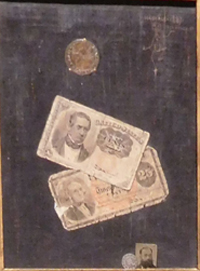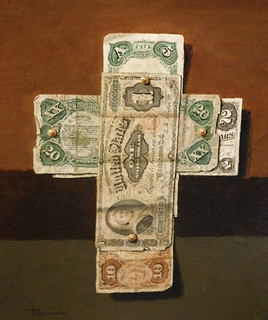
PREV ARTICLE
NEXT ARTICLE
FULL ISSUE
PREV FULL ISSUE
TROMPE L’OEIL ART AT THE CRYSTAL BRIDGES MUSEUMMike Thorne published a nice article in Coins Magazine about numismatic art he'd seen while visiting the Crystal Bridges Museum in Bentonville, Arkansas. It was posted to
the Numismatic News web site March 13, 2017. Here's an excerpt. -Editor
The art that I found most striking, however, consisted of two paintings, one by John Haberle and the other by Victor Dubreuil. You can be forgiven if you’ve never heard of these artists, as I had never heard of them either. Haberle lived from 1856 to 1933 and has been called an “American Master of Money Paintings.” Little is known about Dubreuil other than that he seemed to be obsessed with money in his paintings. Both men were painters in the trompe l’oeil style. Trompe l’oeil is French for “fool the eye.” Paintings in this style aim to deceive the viewer, to depict items with such realism that the viewer will perceive them as real. Haberle painted in this style until 1893, when failing eyesight prevented him from performing the precise work necessary to create his “illusions.” Haberle first encountered trompe l’oeil painting in 1884, when he took some classes at New York City’s National Academy of Design. As a painter in this style, Haberle was one of a number of artists working in America at about the same time. Two others were William Harnett and John F. Peto. Comparing the three men, art historian Alfred Frankenstein wrote: “Peto is moved by the pathos of used-up things. Haberle is wry and wacky, full of bravado, self-congratulating virtuosity, and sly flamboyance. He works largely within an old tradition, that of the trompe l’oeil still life in painted line.… It is poles away from Harnett’s sumptuosity [having a quality of lavishness], careful balances and well-modeled volumes, and is equally far from Peto’s sensitivity in matters of tone and hue.” Frankenstein also pronounced Haberle the “greatest American master of the [trompe l’oeil] tradition.” About Dubreuil he wrote: “He was obsessed with money, doubtless, because he never had any.”
By contrast, the 25-cent note is worn out, with a missing segment extending into Washington’s portrait. This gap appears to be crudely filled with a postage stamp, the back of which is visible. At the very bottom of the painting, ostensibly stuck into the frame, is the silver three-cent piece. It’s next to what appears to be a tiny photo of a bearded gentleman. According to the museum’s write-up for the painting, this “…is a self-portrait which Haberle likely included to defy these authorities [U.S. Secret Service] and express pride in his work. He also included humorous personal references such as the signature with stick figure that seems to be carved into the surface.” This is located in the upper right corner of the painting. Printing above and to the right of the stick figure reads, “J. Haberle 1887 New Haven CT.”
Numismatic trompe l’oeil art has long been a special interest of mine, one which drew me to the work of modern "money artist" J.S.G. Boggs. There are many parallels in the
legal troubles of these artists, whose work is a delight for collectors of art and money alike. -Editor
To read the complete article, see:
THE BOOK BAZARREWayne Homren, Editor The Numismatic Bibliomania Society is a non-profit organization promoting numismatic literature. See our web site at coinbooks.org. To submit items for publication in The E-Sylum, write to the Editor at this address: whomren@gmail.com To subscribe go to: https://my.binhost.com/lists/listinfo/esylum All Rights Reserved. NBS Home Page Contact the NBS webmaster 
|


